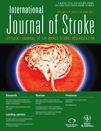
International Journal of Stroke
Scope & Guideline
Empowering Clinicians with Evidence-Based Strategies
Introduction
Aims and Scopes
- Clinical Stroke Management:
The journal publishes studies that enhance clinical practices in stroke management, including thrombolysis, thrombectomy, and secondary prevention strategies. - Neuroimaging and Biomarkers:
Research on neuroimaging techniques and biomarkers that predict stroke outcomes and guide treatment decisions is a core focus area. - Rehabilitation and Recovery:
Papers addressing rehabilitation strategies, patient outcomes, and quality of life post-stroke highlight the journal's commitment to improving recovery processes. - Epidemiology and Public Health:
The journal includes studies that explore the epidemiology of stroke, its risk factors, and socioeconomic implications across various populations. - Innovative Therapies and Technologies:
Research on novel therapeutic approaches, including pharmacological treatments and technological advancements in stroke care, is a significant contribution to the field. - Patient-Centered Care:
The journal emphasizes research that incorporates patient perspectives, experiences, and outcomes, particularly in relation to stroke recovery and rehabilitation.
Trending and Emerging
- Telemedicine and Remote Care:
There is a significant increase in studies exploring telemedicine applications for stroke care, especially in the context of the COVID-19 pandemic, highlighting its role in improving access and outcomes. - Artificial Intelligence and Machine Learning:
Research utilizing AI and machine learning for stroke diagnosis, treatment optimization, and outcome prediction is rapidly emerging as a key area of interest. - Multidisciplinary and Holistic Approaches:
An increasing trend towards multidisciplinary care models that integrate various healthcare providers and address the comprehensive needs of stroke survivors is evident. - Patient and Caregiver Engagement:
Studies focusing on the involvement of patients and caregivers in stroke care and rehabilitation decision-making processes are gaining traction. - Advanced Neuroimaging Techniques:
There is a growing emphasis on advanced neuroimaging methods, such as perfusion imaging and machine learning applications to improve stroke diagnosis and management. - Health Equity and Disparities in Stroke Care:
Emerging research addressing health disparities and the impact of socioeconomic factors on stroke outcomes reflects a heightened awareness of equity in healthcare.
Declining or Waning
- Traditional Pharmacological Interventions:
There seems to be a waning emphasis on studies solely focused on traditional pharmacological approaches without integrating newer therapeutic strategies or technologies. - Basic Science Research:
The journal has seen a decrease in basic science studies that do not directly relate to clinical outcomes or practical applications in stroke care. - Single-Center Studies:
There is a noticeable decline in the publication of single-center studies, with an increasing preference for multicenter and collaborative research efforts. - Historical Epidemiological Studies:
While epidemiology remains a vital area, the focus has shifted towards more contemporary studies that address current public health challenges rather than purely historical data.
Similar Journals

Archives of Neuroscience
Bridging research and clinical practice for a healthier brain.Archives of Neuroscience is a multidisciplinary journal dedicated to advancing the field of neuroscience through the publication of original research articles, review papers, and case studies. Published by BRIEFLAND, this journal aims to bridge the gap between neuroscience research and clinical applications, fostering a deeper understanding of brain function, neurological disorders, and potential therapeutic approaches. With an ISSN of 2322-3944 and an E-ISSN of 2322-5769, Archives of Neuroscience serves as an essential platform for researchers, professionals, and students alike, encouraging open access to knowledge and insights that drive innovation in the field. Although coverage was discontinued in Scopus from 2016 to 2017, the journal continues to uphold rigorous standards of academic excellence, making it a valuable resource for the neuroscience community seeking to explore and disseminate new findings. The journal is committed to providing timely access to research tools and findings that are crucial for informed decision-making in both academic and clinical settings.
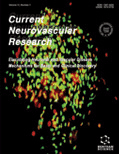
CURRENT NEUROVASCULAR RESEARCH
Exploring the Intersections of Neuroscience and Vascular HealthCURRENT NEUROVASCULAR RESEARCH is an esteemed peer-reviewed journal published by Bentham Science Publishers Ltd, focusing on the intricate relationships within the realms of cellular and molecular neuroscience, developmental neuroscience, and neurology. With an ISSN of 1567-2026 and an E-ISSN of 1875-5739, this journal has been contributing to the field since its inception in 2004 and is poised to continue through 2024. As a resource dedicated to disseminating innovative research findings, CURRENT NEUROVASCULAR RESEARCH is recognized within Category Quartiles as Q3 in multiple fields, including Neurology (clinical) and Developmental Neuroscience. Although classified in the Q4 category for Cellular and Molecular Neuroscience, the journal maintains a crucial role in fostering academic discourse and advancing our understanding of neurovascular dynamics. Researchers, professionals, and students will find valuable insights in this journal, offering access to a diverse range of studies that highlight cutting-edge developments in the field.

NEUROLOGY
Connecting professionals with cutting-edge neurological findings.NEUROLOGY, published by Lippincott Williams & Wilkins, stands as a premier journal in the field of neurology, holding an esteemed Q1 category ranking in clinical neurology as of 2023. Established in 1951, this journal has been a critical resource for the dissemination of cutting-edge research and clinical advancements, with an impressive Scopus rank of 24 out of 400, placing it in the 94th percentile among its peers. NEUROLOGY serves as a vital platform for neurologists, researchers, and medical professionals seeking to stay abreast of the latest findings and innovations in the treatment and understanding of neurological disorders. With its rigorous peer-review process and commitment to excellence, NEUROLOGY remains essential reading for all individuals dedicated to advancing the science and practice of neurology, contributing significantly to the ongoing dialogue in this vital area of medicine.
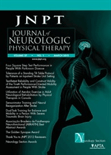
Journal of Neurologic Physical Therapy
Advancing Rehabilitation through Neurologic InsightsJournal of Neurologic Physical Therapy, published by Lippincott Williams & Wilkins, stands as a premier resource in the field of physical therapy with a specific focus on neurology. With an ISSN of 1557-0576 and an E-ISSN of 1557-0584, this journal serves as a vital platform for researchers, practitioners, and students from 2004 to 2024, illustrating its commitment to advancing knowledge in neurologic rehabilitation. It holds a prestigious Q1 ranking in categories such as Physical Therapy, Sports Therapy, and Rehabilitation and Rehabilitation, alongside Q2 rankings in Geriatrics and Gerontology, Medicine (Miscellaneous), and Neurology (Clinical). With an impact factor that reflects its significance, the journal hosts comprehensive studies and clinical insights that propel practice and innovation in neurologic physical therapy. The content is designed to enhance understanding and skills, making it an indispensable resource for those dedicated to improving patient care and outcomes in this critical area of health.
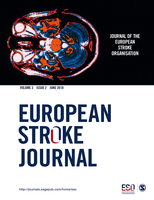
European Stroke Journal
Connecting researchers and clinicians for impactful stroke solutions.The European Stroke Journal, published by SAGE Publications Ltd, is a pivotal resource in the domains of Cardiology and Neurology, reflecting its commitment to advancing knowledge and research in these critical areas of medicine. Since its inception in 2016, this journal has rapidly gained recognition, achieving a prestigious Q1 ranking in both Cardiology and Neurology (clinical) as of 2023, placing it among the top quartile publications in these fields. With a prominent position, ranked 65th and 72nd respectively in Scopus for Cardiology and Neurology, the journal caters to a diverse audience of researchers, clinicians, and students dedicated to improving stroke treatment and prevention strategies. Although it operates under a traditional access model, its impactful publications are essential for anyone involved in stroke research, ensuring they remain at the forefront of scientific developments and clinical practices.

Stroke-Vascular and Interventional Neurology
Pioneering the future of stroke and interventional neurology.Stroke-Vascular and Interventional Neurology, published by WILEY, is a leading open-access journal dedicated to advancing the field of neurology with a particular focus on stroke and vascular interventions. Since its inception in 2021 as an open-access journal, it has fostered a collaborative environment for researchers, clinicians, and educators to share innovative findings and clinical practices that address the complexities of cerebrovascular diseases. The journal emphasizes high-quality, peer-reviewed research articles, reviews, and case studies, providing critical insights into cutting-edge therapies and surgical techniques. With an ISSN of 2694-5746, it aims to support the global medical community in improving the diagnosis, treatment, and overall management of stroke patients. Researchers and healthcare professionals benefit from its accessible content, which is vital for fostering comprehensive understanding and evidence-based practices within the realm of interventional neurology.
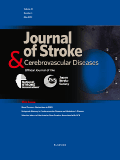
Journal of Stroke & Cerebrovascular Diseases
Connecting Research with Clinical ExcellenceJournal of Stroke & Cerebrovascular Diseases, published by ELSEVIER, is a leading international peer-reviewed journal dedicated to advancing the research and understanding of stroke and cerebrovascular disorders. With an impressive impact factor reflective of its rigorous academic standards, this journal is indexed in the highest echelons of medical disciplines, boasting a Q1 classification in Rehabilitation and prominent rankings in related fields. Established in 1991 and converging its focus toward 2024, it serves as a vital resource for researchers and clinicians interested in the complexities and treatment of cerebrovascular conditions. The journal's broad scope spans essential categories such as cardiology, neurology, and surgery, making significant contributions that enhance clinical practices and patient outcomes. For researchers, professionals, and students alike, the Journal of Stroke & Cerebrovascular Diseases is not just a publication but a critical platform for sharing innovative findings and fostering impactful discussions within the medical community.
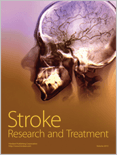
Stroke Research and Treatment
Elevating the discourse in stroke research and treatment.Stroke Research and Treatment is a premier Open Access journal published by HINDAWI LTD, dedicated to advancing the understanding and management of stroke and related neurological disorders. Since its inception in 2010, this journal has established itself as a valuable resource for researchers and clinicians in the field of neurology, providing a platform for high-quality, peer-reviewed articles that aim to improve patient outcomes and stimulate clinical practice innovations. With a 2023 Scopus ranking placing it in the Q3 category and a percentile ranking of 44th in clinical neurology, the journal is positioned to influence the ongoing discourse in stroke research. Stroke Research and Treatment embraces a global audience, with its editorial operations based in London, England. The journal's commitment to open access ensures that its content is freely available to all, promoting extensive dissemination and engagement in this critical field of study. Researchers, professionals, and students are encouraged to contribute their findings to this dynamic journal, fostering collaboration and knowledge sharing in the ongoing fight against stroke.
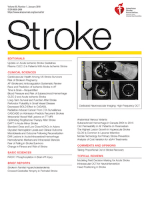
STROKE
Shaping the Future of Stroke Care and ResearchSTROKE is a premier academic journal published by Lippincott Williams & Wilkins, dedicated to advancing the fields of neurology, cardiology, and specialized nursing. With an impressive impact factor and consistently ranked in the Q1 category across multiple disciplines—such as Advanced and Specialized Nursing, Cardiology, and Neurology—this journal serves as a crucial platform for researchers and healthcare professionals. It spans a rich historical context from 1970 to 2024, offering invaluable insights into stroke research and related cerebral vascular issues. The journal is committed to disseminating high-quality research that informs clinical practices and guides policy-making in public health. With a focus on empirical studies and clinical trials, STROKE stands as an essential resource for those invested in the complexities of neurological interventions and cardiovascular health. Ensure your access to this influential publication as it shapes the future of medical science and patient care.

Clinical Neuroradiology
Empowering Professionals with the Latest in Neuroradiology.Clinical Neuroradiology, published by SPRINGER HEIDELBERG, is a leading journal in the fields of neurology and radiology, focusing on the intersection of clinical practice and cutting-edge imaging technologies. With an impressive impact factor and categorized within Q2 in Neurology (clinical) and Q1 in Radiology, Nuclear Medicine and Imaging, this journal is positioned at the forefront of scientific discourse, facilitating high-quality research dissemination from its origins in 2000 through to 2024. Situated in Germany, Clinical Neuroradiology provides a platform for researchers, professionals, and students to explore the latest advancements and insights in neuroimaging, ensuring that its readership remains at the vanguard of clinical practice. While it does not offer open access, the journal remains committed to fostering a vibrant academic community dedicated to enhancing patient care through innovative neuroradiological techniques and findings.